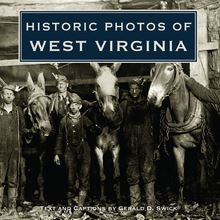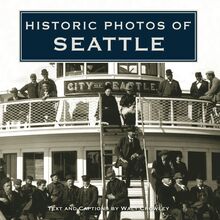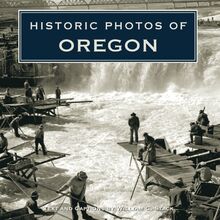Historic Photos of North Carolina , livre ebook
190
pages
English
Ebooks
2008
Vous pourrez modifier la taille du texte de cet ouvrage
Obtenez un accès à la bibliothèque pour le consulter en ligne En savoir plus
Découvre YouScribe et accède à tout notre catalogue !
Découvre YouScribe et accède à tout notre catalogue !
190
pages
English
Ebooks
2008
Vous pourrez modifier la taille du texte de cet ouvrage
Obtenez un accès à la bibliothèque pour le consulter en ligne En savoir plus
Publié par
Date de parution
22 octobre 2008
Nombre de lectures
0
EAN13
9781618586605
Langue
English
Poids de l'ouvrage
9 Mo
Native North Carolinians tend to learn the state toast (adopted by the General Assembly in 1957) in childhood. As with the state motto, Esse Quam Videri (To be rather than to seem), such words from the toast as "Here’s to the land of the longleaf pine” hold an amazing power to inspire the varied denizens of North Carolina, a state with deep and varied agricultural and industrial histories.
Words are fine for inspiration, and for recording the achievements of those who once heard or spoke such words. However, a single photograph offers a window into a lost past that is difficult to capture in words alone. This volume, Historic Photos of North Carolina, provides nearly 200 such glimpses of life in the Tar Heel State. From the mid-1800s through the mid-1900s, from Cape Hatteras to Asheville, from scenes of farm families working in the fields to Orville Wright in flight at Kill Devil Hills, these historic black-and-white images seek to capture the essence of change in the land of the longleaf pine.
Publié par
Date de parution
22 octobre 2008
EAN13
9781618586605
Langue
English
Poids de l'ouvrage
9 Mo
HISTORIC PHOTOS OF
NORTH CAROLINA
T EXT AND C APTIONS BY W ADE G. D UDLEY
By 1860, much of North Carolina remained undeveloped and isolated, particularly in its western mountains, where this image of Lake Lure and Mount Mitchell bears little resemblance to the center of tourism existing today. According to the census of that year, the entire population of the state numbered fewer than a million people-661,563 free citizens and 331,099 slaves-and Wilmington, the state s largest urban area, held only 9,553 souls.
HISTORIC PHOTOS OF
NORTH CAROLINA
Turner Publishing Company
200 4th Avenue North Suite 950
Nashville, Tennessee 37219
(615) 255-2665
www.turnerpublishing.com
Historic Photos of North Carolina
Copyright 2008 Turner Publishing Company
All rights reserved.
This book or any part thereof may not be reproduced or transmitted in any form or by any means, electronic or mechanical, including photocopying, recording, or by any information storage and retrieval system, without permission in writing from the publisher.
Library of Congress Control Number: 2008901709
ISBN: 978-1-59652-451-4
Printed in China
09 10 11 12 13 14-0 9 8 7 6 5 4 3 2
C ONTENTS
A CKNOWLEDGMENTS
P REFACE
C IVIL W AR AND R ECOVERY (1860-1899)
T HE P ROGRESSIVE D ECADES (1900-1919)
T O AND T HROUGH THE G REAT D EPRESSION (1920-1939)
T HE W AR AND G ROWTH (1940-1960)
N OTES ON THE P HOTOGRAPHS
A family excursion on the Julia Bell in the 1880s provides a break from the workaday world. For most families along the miles of rivers, sounds, and sea in North Carolina, small craft were a necessity. They provided effective transportation where roads did not reach, brought food to the table, and provided extra income when surplus fish and shellfish made their way to local markets.
A CKNOWLEDGMENTS
This volume, Historic Photos of North Carolina , is the result of the cooperation and efforts of many individuals, organizations, and corporations. It is with great thanks that we acknowledge the valuable contribution of the following for their generous support:
Library of Congress
North Carolina State Archives
As always, the helpful staff of the Verona Joyner Langford North Carolina Collection at East Carolina University met my needs for data, both great and (sometimes) a little odd. Special thanks go to my teaching assistant for 2007-2008, Ms. Monica Ayhens, and to the numerous students in my North Carolina History classes who constantly challenge and inspire me to learn even more about this great state.
- Wade G. Dudley
P REFACE
About 30 distinct tribes of Native Americans occupied the land that would become North Carolina when the first Europeans arrived. By the time the first settlements-by Spaniards along the Cape Fear River in the 1520s, and the English at Roanoke Island in the 1580s-had failed, the native dwellers already suffered from diseases brought by these pale-skinned strangers. Within a century, several tribes had disappeared, victims of the twin ravages of disease and war. Within two centuries, only the Cherokee remained outside reservations-and their days of freedom were numbered.
The first permanent English settler of record in the lands that became North Carolina was Nathaniel Batts from the Virginia Colony. In 1655, he established a fur-trading post at the confluence of the Roanoke and Chowan rivers. Other Virginians followed, bringing with them the institution of slavery. By 1776, the Royal Colony of North Carolina claimed colonists of numerous origins, from freedmen to Scots Highlanders to Moravian Germans, with some two dozen languages and dialects, at least, scattered from coast to mountains. No matter the language spoken, those who remained in the colony in the years following April 12, 1776, and adoption of the Halifax Resolves agreed that North Carolina would be free of British rule. Thus the colony became a state, and the state became part of a great nation.
The Old North State, as it came to be called, had another nickname in its early years: the Rip Van Winkle State. It seemed to be asleep, trapped in a stagnant agricultural system of yeoman and subsistence farmers dominated by plantation owners in the coastal regions and river valleys. Slowly, that began to change with the introduction of a textile industry and improvements to the state s transportation infrastructure, notably the building of railroads and the use of steamships.
On the eve of the Civil War, North Carolina remained underindustrialized and absolutely dependent upon agriculture, especially cotton, for revenue. However, with only a quarter of its families owning one or more slaves and few plantations to rival those of Virginia and South Carolina, the state initially resisted abandoning the Union for the new-fledged Confederacy. The secession of Virginia and President Lincoln s call for troops from North Carolina to actually march into its sister states overcame that resistance; most North Carolinians would not fire on their Southern brothers. So war came to the state, bringing with it another sobriquet: Tar Heels, for the tenacity of North Carolinians on the battlefield became well known.
With the exception of cropping images where needed and touching up imperfections that have accrued over time, no other changes have been made to the photographs in this volume. The caliber and clarity of many photographs are limited by the technology of the day and the ability of the photographer at the time they were made. Before the Civil War, and even during it, few photographs of North Carolina existed (or survived in reproducible form) other than portraits, so 1860 became a logical starting point for this photographic study. As the decades crawled along, the number of photographs available increased dramatically, thus the challenge became selecting those images that would reproduce clearly while still telling the story of this marvelous state and its people. Even then, there were problems, as many photographs had been snapped at random or else lacked identifiers, while some key issues in state history either never received the attention of a photographer or the related photographs remain unavailable in private collections.
Thus this book is a history, of sorts, but a history told primarily with photographs: random seconds in time frozen forever by the flash of a camera. Words can be twisted, but these images offer a very solid reality of their own. This is, of course, a study of change, and I have made little effort to provide it with a thematic structure-other than change itself. And though I have provided some background and interpretation of the photographs (and accept the responsibility for any errors therein), I urge you to let the pictures tell their own story of our beloved Old North State.
- Wade G. Dudley
Two crewmen stand on a quay in Washington, locally known as Little Washington, alongside their oystering boat in 1884. The introduction of refrigerated railcars in the 1870s and refrigerated cargo vessels in the 1880s meant new markets for shellfish from the Carolina sounds. In modern times, overfishing and pollution have reduced this delicious bounty.
C IVIL W AR AND R ECOVERY
(1860-1899)
The 1850s saw the continued entrenchment of slavery in North Carolina. Despite this, the state hesitated to join the Deep South in rebellion until Lincoln called upon it for troops to suppress that rebellion and Virginia withdrew from the Union. Reluctant or not, North Carolina provided one-sixth of the Confederacy s soldiers though it held only one-ninth of the South s white population. Wilmington prospered as the last open port for the Confederacy, and the Wilmington Weldon Railroad carried materiel and munitions to keep the Army of Northern Virginia in the war into 1865.
The Old North State became a battleground in 1861 with the Union invasion of the Outer Banks, the capture of Roanoke Island, and the securing of a mainland toehold that stretched from New Bern to Elizabeth City by early 1862. Periodic raids threatened towns farther inland and sought to disrupt rail communications. Though Fort Fisher on the Cape Fear River defeated an invasion attempt in late 1864, overwhelming Union forces captured it in January 1865. Few resources remained to meet General William T. Sherman s Yankees, and Confederate general Joseph E. Johnston surrendered his army following the Battle of Bentonville in March, ending the war for North Carolina.
With more than 40,000 dead, an economy in shambles, and a social order seemingly turned topsy-turvy, North Carolina slowly began to recover. Agriculture provided a basis for growth, then money invested in new industry-especially textiles, tobacco manufacturing, and furniture-began to return huge profits by the late 1870s. New tycoons invested profits in improving the state s infrastructure. Railroads crept across the state, roads improved, and, by the late 1880s, power lines reached into growing urban centers such as Winston (soon to be Winston-Salem), Charlotte, Greensboro, and Raleigh. Such rapid success also brought its share of corruption, especially with railroad investments.
As industry and old money produced a near-plutocracy in a state government dominated after 1876 by Bourbon Democrats, falling markets drove farmers to bankruptcy and de facto segregation threatened the newly granted civil rights of former slaves. In the 1890s, a fusion of the Populist Party and the Republicans wrested power from the Democrats for a few years, but this progressive alliance collapsed beneath the weight of anti-black sentiment in the state. By 1900, Democrats held firm control of the state, and segregation doomed African Americans to several generations of second-class citizenship.
Built on the Cape Fear River, the Confederate outpost Fort Fisher guarded the port of Wilmington, a haven for blockade runners throughout most of the Civil War. By 1864, Wilmington and the Wilmington Weldon Railroad had together earned th














